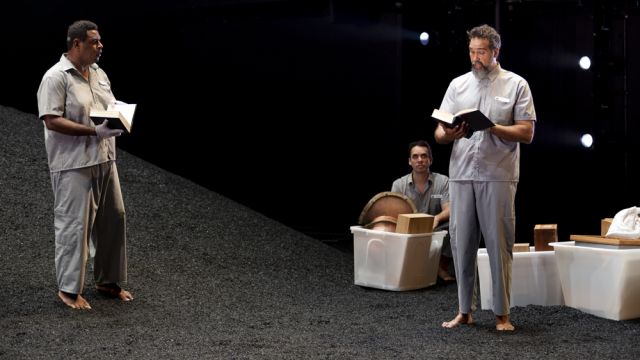The Return
The Return is a beautifully conceptualised play. It takes on a very difficult and disturbing topic in a hard-hitting manner whilst also being extremely delicate and sensitive in its delivery. The issue of returning Indigenous remains to Country is one of the horrific repercussions of a heartless colonial culture that is, unfortunately, part of Australia's shameful history. The play makes the unequivocal and fundamental statement that these remains continue, to this day, to be treated as commercial artefacts. This is done despite knowing that to First Nations communities they are the remains of their loved ones who have been denied their appropriate resting place.

This point comes across very forcefully by highlighting the long history of this tragic exploitation. The story is woven across a variety of spheres such as museum board meetings, museum exhibition and storage spaces, and grave robbing sites. These spheres intersect in an eerie and monumental space, created by a large mound of black earth. This gives the set a very surreal appearance. This strange and somewhat timeless setting is occupied by absurd characters, all of whom are depicted in epic proportions (in the very Brechtian sense of the word). Each of the performers capture the perverse nature of this story perfectly, striking a tone which expertly and deliberately hovers between satire and social realism. Ghenoa Gela is absolutely delightful in the way she achieves this across her various roles.

The narrative unfolds in a non-linear fashion and although this can make the historical detail difficult to pinpoint, the direction of the story is always crystal clear. There are many poignant moments in this play and one of the most striking is the exchange between The Curator (Laila Thaker) and The Director (Damion Hunter). The Director hands over some precious remains to The Curator who is keen to return them to their community only to be immediately coerced into keeping them as museum property in order to attract future funding. The sheer warped logic of such exchanges is fully explored in this play and the farcical elements of the story gradually evolve into macabre realties. The resulting imagery is often gruesome, and exposes a very flawed and perfidious Darwinian inspired thinking. There are moments in the performance that are genuinely difficult to watch and the violence they depict is conveyed solely by simple but evocative gestures and cold, ruthless medical discourse.

The play ends with a magnificent burial ceremony and provides a glimpse into some form of hope that closure might be achieved. This brings an incredibly moving play to a very emotional conclusion. This performance provides a unique and arousing theatrical experience that subtlety blends a range of theatrical traditions. The show makes an important statement without inhibition and with enormous grace and style.
Patricia Di Risio
Photographer: Pia Johnson
Subscribe to our E-Newsletter, buy our latest print edition or find a Performing Arts book at Book Nook.

